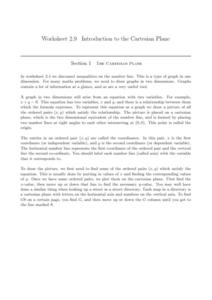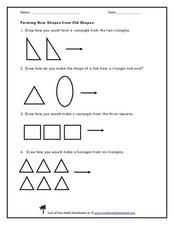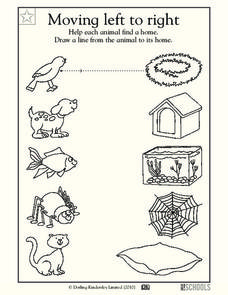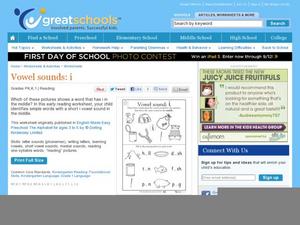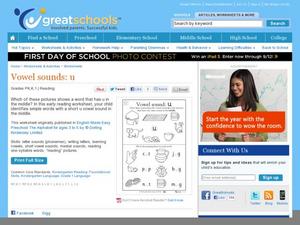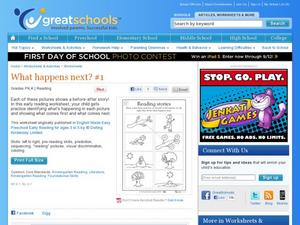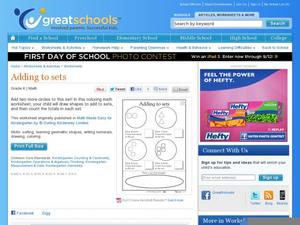Curated OER
Art Basics Scavenger Hunt
Hand out this learning exercise and lead your class on a scavenger hunt. Pupils look for examples of shape, form, balance, pattern, perspective, space, and depth. They draw and write about the examples they've found. A great...
Curated OER
The Cartesian Plane
Learners solve and complete 22 various types of problems. First, they find the gradients of the lines and plot the given points. Then, they complete the table of values for each equation and use the table to draw the graph.
Curated OER
Studying our Senses
Who would not want an opportunity to taste jellybeans in class? During this investigation, life science learners hold their noses as they take a taste test and find that our perception of flavor is connected with our sense of...
Curated OER
Chemical Formula Practice #1/Bonding Basics Practice Page
The first of two worksheets methodically prepares chemistry novices for naming polyatomic compounds. It begins by having them acknowledge the number of each atom contained in a molecule. Then learners list the valence electrons for a...
Curated OER
Document Interpretation Exercise
Dorothea Lange’s photograph, Migrant Mother, and The Paycheck by Rick Nahimias, provide learners with an opportunity to practice their document interpretation skills. After a careful study of the images, class members develop a detailed...
Curated OER
Forming New Shapes from Old Shapes
Shapes can be joined together to make new shapes! Young geometers experience this phenomenon as they examine four shape challenges in this worksheet. Scholars create a rectangle from two right triangles and a fish from an oval and a...
Curated OER
Moving Left to Right
These animals need to find their homes! Young scholars help them by drawing lines from each animal on the left to its habitat on the right. There is no guessing to be done here, though; pairs are directly across from one another. They...
Curated OER
Match the Pictures
Which of these objects are the same? Get your pre-readers comfortable with identifying objects that are identical, focusing on the term same. They examine eight pictures, drawing a line between those that are the same. The objects should...
Curated OER
Matching Directions
Which shape is pointing the same way? There are five starting shapes here, all irregular. Learners examine a row of shapes following each and draw a circle around the one that is pointing the same way. Enforce directional vocabulary by...
Curated OER
Match the Rhymes
Focus on the short u sound in this rhyme worksheet for emergent readers. Learners examine images surrounding a jug, drawing lines to connect it to those that rhyme (bug, rug, mug). Then, they practice their printing by tracing the...
Curated OER
Vowel Sounds: A
Say aaaaa, because today your class will be practicing the short a vowel sound. They complete two activities. First the draw a line from the letter a to the objects that contain the medial /a/ sound. Then, they fill in the missing a to...
Curated OER
Vowel Sounds: e
"Eh?" That is the short vowel sound the letter e makes when it is used in the middle of a word. Little ones will draw a line between the letter e and objects that make the short e sound. Then they will fill in the missing e in six...
Curated OER
Vowel Sound: i
As scholars become more comfortable with initial sound correspondence, introduce them to medial sounds. As they focus on the vowel sound /i/, youngsters examine a set of images and draw a line from the letter i to any with that...
Curated OER
Vowel Sounds: O
This worksheet focuses on the medial vowel sound o. Pre-readers complete two tasks to practice the short o sound. They draw a line from the letter o to pictures that contain the medial /o/ sound. They then, fill in six cvc words with the...
Curated OER
Vowel Sound: u
Which of these have /u/ as a middle sound? There are images of seven CVC words surrounding the letter u here, and scholars draw lines from the letter to words with the same middle phoneme. Be sure they know what these images are...
Curated OER
What Happens Next? 1
Knowing how to sequence events means you have to know what happens before and after. Little ones draw a line from four before images to the images that show what happened next. This is a good challenge for your youngest learners.
DK Publishing
Adding to Sets
After adding to several sets of shapes, scholars count the number in each set and write the total in a box. There are four sets here calling for one, two, three, and four more shapes to be added to the existing figures. A final bonus...
DK Publishing
Counting Bugs! - Numbers and Pictures
Youngsters become familiar with single-digit numbers as they count bugs and represent the value in three forms. For each, scholars write the number in both numerical and word form and also fill in dots on a domino. After completing...
Curated OER
More Than
These pictures need more! Before youngsters are able to count, they can comprehend the concept of more; help strengthen pre-reading and counting skills using this drawing activity. They examine three pictures and add more to each. A...
Curated OER
Symmetry
Where is the line of symmetry? Learners begin by drawing in a line to split three images evenly in half, using an example as reference. Encourage them to think about physically folding the picture to solidify this concept. Next, they do...
DK Publishing
Thin, Thinner, Thinnest
Reinforce comparative adjectives and relative size with a drawing activity. Kindergartners study a thin house and a thin balloon, then draw a thinner version of each. They also choose the thinnest bottle and lollipop in a group. Focus on...
Curated OER
Thick, Thicker, Thickest
Do your kindergartners know the difference between thick and thin? After reviewing a picture of a tree and a candle, kids draw a thicker version of each in the space provided. They also draw a ring around the thickest pencil and the...
Curated OER
Bones Provide Great Support!
How do bones help people move around? A science investigation prompts kids to draw arrows to certain bones that protect their organs. After they finish, they trace their hands on a piece of paper and trace the way their bones go. Great...
Curated OER
Does It Move On It's Own?
Young scientists look at drawings of six animals, then match up a word that describes how they move. The words are: hop, crawl, swim, fly, run, and jump. They also answer two additional questions about the animals and how they move. A...
Other popular searches
- Scale Drawings
- Grid Drawings
- Isometric Drawings
- Drawings Weather Instruments
- Mitosis Drawings
- Construct Scale Drawings
- Rube Goldberg Drawings
- Cad Drawings
- Chalk Drawings
- Figure Drawings
- Flower Drawings
- Math Vocabulary Drawings

